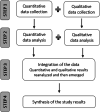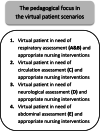The value of a redesigned clinical course during COVID-19 pandemic: an explorative convergent mixed-methods study
- PMID: 35461292
- PMCID: PMC9034970
- DOI: 10.1186/s12912-022-00872-8
The value of a redesigned clinical course during COVID-19 pandemic: an explorative convergent mixed-methods study
Abstract
Background: The COVID-19 lockdown in March 2020 had a significant consequence for nursing students worldwide including limited access to learning situations in clinical rotation. Therefore, this study aims to explore how an innovative redesign of a clinical course in a time of pandemic supported nursing students in learning the fundamentals of care in their first year. The redesign involved the transformation of a traditional hands-on clinical course into a technology-enhanced learning environment.
Design: This was an explorative convergent mixed-methods study using both quantitative and qualitative methods.
Methods: Twenty-four first-year nursing students responded to an online questionnaire with open-ended questions. Two nursing students and one faculty member participated in individual online interviews, and three faculty members participated in an online focus group interview. All the data were collected in June 2020. The quantitative data were analyzed using descriptive statistics and the qualitative data using content analysis. The GRAMMS guideline was applied.
Results: The students achieved the learning outcomes regarding fundamental care, basic physical assessment skills, and clinical reasoning with the help of academic assignments, multimedia learning resources, and virtual patients. Further, six central aspects of the facilitator role in the virtual simulation were identified. The aspect that was considered most valuable involved uncovering the "red thread" between different areas of knowledge in the first year of nursing education; this supported the students to better understand how to think and talk like a nurse.
Conclusion: This study offers insight into how a technology-enhanced clinical course can foster the learning of fundamental nursing care, basic physical assessment skills, and clinical reasoning skills; enhancing students' preparedness for clinical hours. Virtual patients' scenarios contributed to integrating different types of knowledge and skills that are important when providing nursing care for patients in clinical practice. This study also highlighted a gap in pedagogical competence among faculty members with regards to facilitating learning in a technology-enhanced learning environment. Study findings suggest promising pedagogical strategies that should be further developed post-pandemic, in response to the call for a renewal of nursing education using more technologically supported learning designs.
Keywords: Clinical competence; Clinical reasoning; Computer simulation; Education nursing; Education, clinical; Nursing; Nursing skills; Student nursing.
© 2022. The Author(s).
Conflict of interest statement
The authors declare that there are no conflicting interests.
Figures





Similar articles
-
[Impact of Nurse Practitioners and Nursing Education on COVID-19 Pandemics: Innovative Strategies of Authentic Technology-Integrated Clinical Simulation].Hu Li Za Zhi. 2021 Oct;68(5):4-6. doi: 10.6224/JN.202110_68(5).01. Hu Li Za Zhi. 2021. PMID: 34549401 Review. Chinese.
-
Student and educator experiences of maternal-child simulation-based learning: a systematic review of qualitative evidence protocol.JBI Database System Rev Implement Rep. 2015 Jan;13(1):14-26. doi: 10.11124/jbisrir-2015-1694. JBI Database System Rev Implement Rep. 2015. PMID: 26447004
-
Configuration of Mobile Learning Tools to Support Basic Physical Assessment in Nursing Education: Longitudinal Participatory Design Approach.JMIR Mhealth Uhealth. 2021 Jan 7;9(1):e22633. doi: 10.2196/22633. JMIR Mhealth Uhealth. 2021. PMID: 33410756 Free PMC article.
-
Factors associated with changes in students' self-reported nursing competence after clinical rotations: a quantitative cohort study.BMC Med Educ. 2023 Feb 11;23(1):107. doi: 10.1186/s12909-023-04078-7. BMC Med Educ. 2023. PMID: 36774493 Free PMC article.
-
Learning practical nursing skills in simulation centers - A narrative review.Int J Nurs Stud Adv. 2022 Jul 22;4:100090. doi: 10.1016/j.ijnsa.2022.100090. eCollection 2022 Dec. Int J Nurs Stud Adv. 2022. PMID: 38745621 Free PMC article. Review.
Cited by
-
Exploring facilitation in virtual simulation in nursing education: A scoping review.PEC Innov. 2023 Nov 20;3:100233. doi: 10.1016/j.pecinn.2023.100233. eCollection 2023 Dec 15. PEC Innov. 2023. PMID: 38033419 Free PMC article.
-
Inclusive pedagogy in online simulation-based learning in undergraduate nursing education: A scoping review.J Adv Nurs. 2025 Feb;81(2):591-606. doi: 10.1111/jan.16284. Epub 2024 Jun 28. J Adv Nurs. 2025. PMID: 38940383 Free PMC article.
-
Recommendations for online learning challenges in nursing education during the COVID-19 pandemic.Curationis. 2022 Oct 27;45(1):e1-e6. doi: 10.4102/curationis.v45i1.2360. Curationis. 2022. PMID: 36331216 Free PMC article. Review.
-
Nurse educators' suggestions for a digital educational resource suitable for undergraduate student nurses' placement studies: Qualitative empirical research.Nurs Open. 2023 Aug;10(8):5433-5445. doi: 10.1002/nop2.1782. Epub 2023 May 4. Nurs Open. 2023. PMID: 37139861 Free PMC article.
-
Association between game metrics in a simulation game and nursing students' surgical nursing knowledge - a quasi-experimental study.BMC Nurs. 2024 Jan 2;23(1):16. doi: 10.1186/s12912-023-01668-0. BMC Nurs. 2024. PMID: 38166830 Free PMC article.
References
-
- EU Directive 2005/36/EC. https://eur-lex.europa.eu/legal-content/EN/TXT/PDF/?uri=CELEX:32005L0036... Accessed 02 03 2021.
-
- Koehler MJ, Mishra P. What is technological pedagogical content knowledge? Contemp Issues Technol Teach Educ. 2009;9(1):60–70.
LinkOut - more resources
Full Text Sources
Miscellaneous

